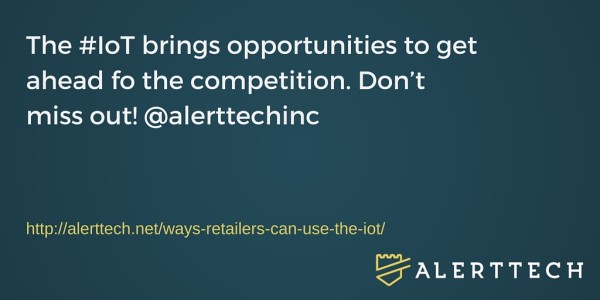Every day, we send information to this mysterious place known here on earth as “the cloud.” This information is shared seamlessly between connected devices as required, without so much as a second thought. Have you ever wondered how your iPad knows where you stopped watching that show on Netflix on your TV? It’s not magic, it’s just one example of the Internet of Things (IoT) in action.
That’s a lot of data going up into the cloud every day! Are you wondering if it’s too much to handle? More importantly, how can all of this data help retailers increase sales and improve the customer experience?
McKinsey & Company recently asked business experts, “What’s the one piece of advice for a business leader interested in the Internet of Things?” When you combine the wisdom gleaned from the McKinsey research with our own retail expertise, you get five practical uses of the IoT for retailers.
5 Smart Ways Retailers Can Use the IoT
1. Get Ahead of the Competition
Most retailers we talk with aren’t even scratching the surface of what is possible with practical applications of big data. There is a critical opportunity here to get ahead of your competition by harnessing and applying the information you already collect from your customers.
- Run the cross-sections of your customer loyalty ZIP code data to find local partners for cross-promotions.
- Use SMS alerts to alert customers to upcoming sales events.
The possibilities are endless, and every opportunity to stand out is one that should not be ignored.
2. Recognize the Potential
Retailers that have applied Beacons technology are already capitalizing on the IoT. It’s an example of thinking about the use of data in the correct order. First, identify the problem, then figure out what data points are required to help to solve it.
I always worry about people jumping to technology to solve a problem without thinking about the problem first. So my answer would be to question what the fundamental problem in your business is and how you would go about solving it. – Dan Kaufman, Deputy Director, Google’s Advanced Technology and Projects Group
When you identify the obstacles to increased sales, you can start to raise the bar in your organization. Maybe it’s identifying omni-channel marketing opportunities, or improving wait-times for the fitting room. One problem at a time, you can start to identify the information that is needed for a solution.
3. Embrace Technology or Get Left Behind
More and more, management expects the data gathered from customers to be put to good use at the store level. However, perhaps more importantly, customers expect that retailers are up to date on the latest and greatest in enhancing their shopping experience. The idea of Buy Online, Pickup in Store (BOPIS) was once deemed futuristic, and now it has become de rigour.
[xyz-ihs snippet=”TOFU2-Retail-Technology-button”]
The successful retailers of the future will be the ones who best identify and then meet the needs of their customer. The interconnectedness of the IoT will be a leading factor in meeting the increasing expectations of customers.
[Tweet “Using the #IoT in #retail isn’t a phase, it’s the way of the future. Don’t get left behind! @alerttechinc”]
4. Thinking Big and Small at the Same Time
When considering retail applications for the IoT, it’s easy to get swept away in the sea of infinite possibilities. Big data brings about big changes, but it can also offer small, incremental changes that can make a huge difference.
For example, we often recommend apparel retailers start with AlertTech’s Sense System call buttons in fitting rooms to gather the following metrics:
- The number of total fitting room visits
- The number of fitting room calls
- The length of response time for fitting room calls
- How long customers are spending in fitting rooms
Once that data is in hand, it can be benchmarked against industry standards. From there, practical solutions, like using people counting to monitor and enhance traffic flows, can be employed.
Related Post: 5 Most Important Retail Industry Benchmarks for Fitting Rooms
5. Enabling a Long-Term Vision
While it’s possible that some data will bring about a few quick wins, winning in retail is like a game of chess. It’s important to look a few moves ahead to stay ahead of your opponent. In many cases, your opponent is the changing tastes and whims of your customer base.
This is something that you can invest in. It certainly won’t give you next quarter, but out a year or two, it could completely change the way you compete. And I don’t think we’re spending anywhere near enough effort on it.– Mark Hatch, Cofounder & CEO of TechShop
The Final Word
Before tossing around buzzwords and trying to secure buy-in to capitalize on all of the value the IoT can provide, make sure it’s done in a meaningful way. A sea of data that serves no useful purpose will not win friends and influence managers. Identify a proven technology partner to help ensure a smooth path forward in the world of big data.
[xyz-ihs snippet=”TOFU-Retail-Analytics-IOT”]

